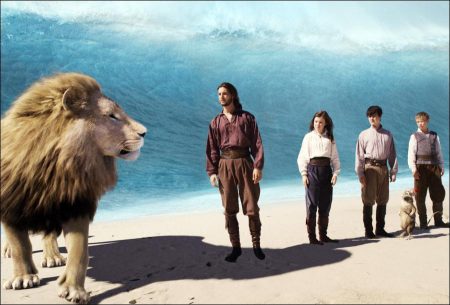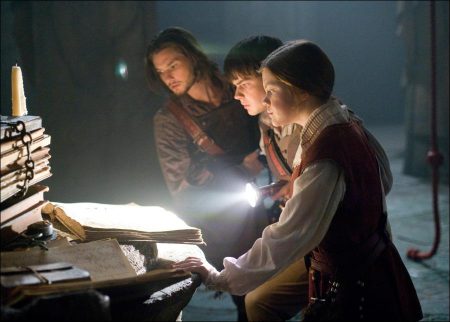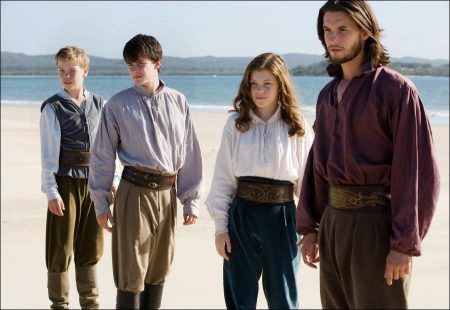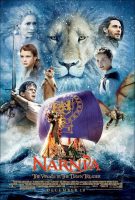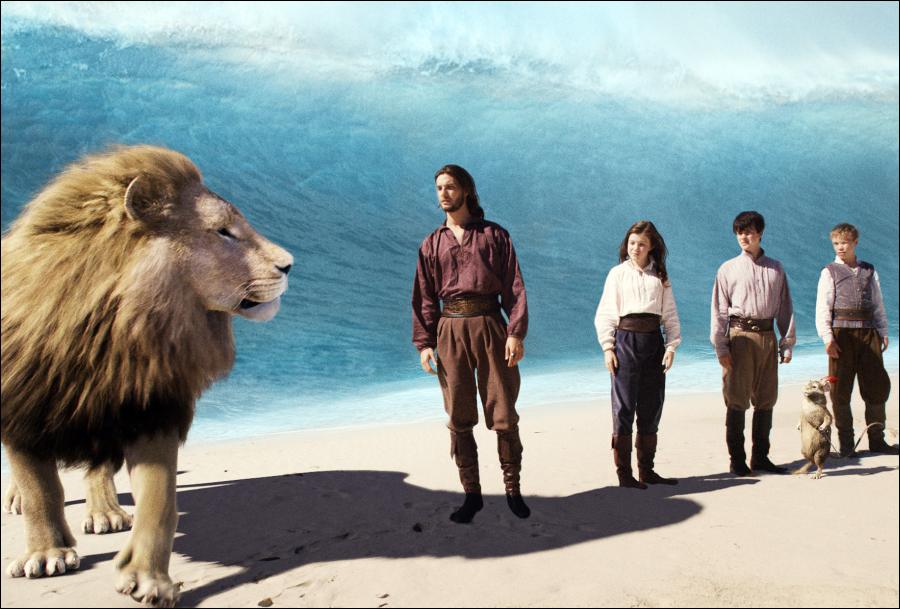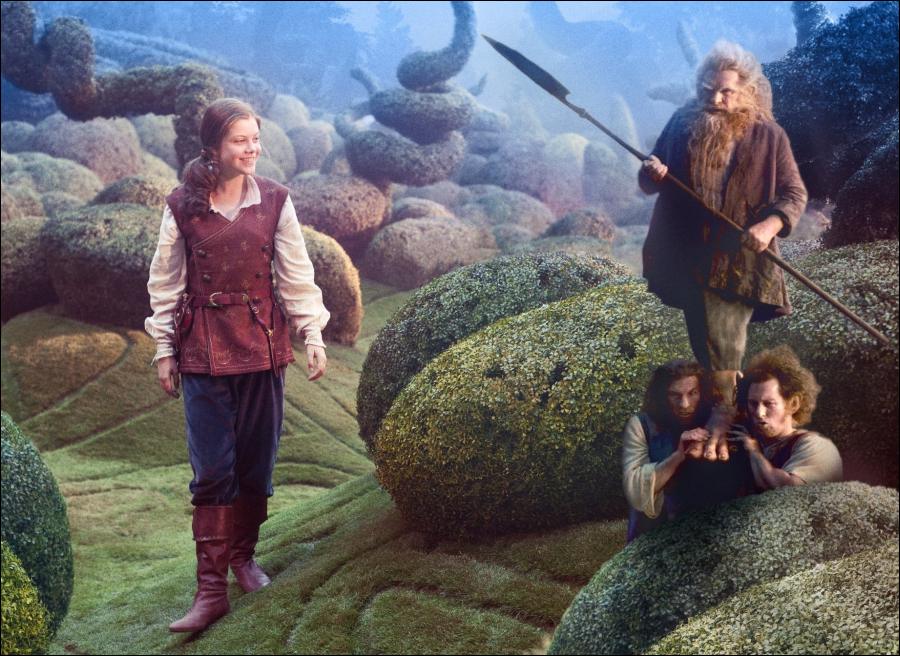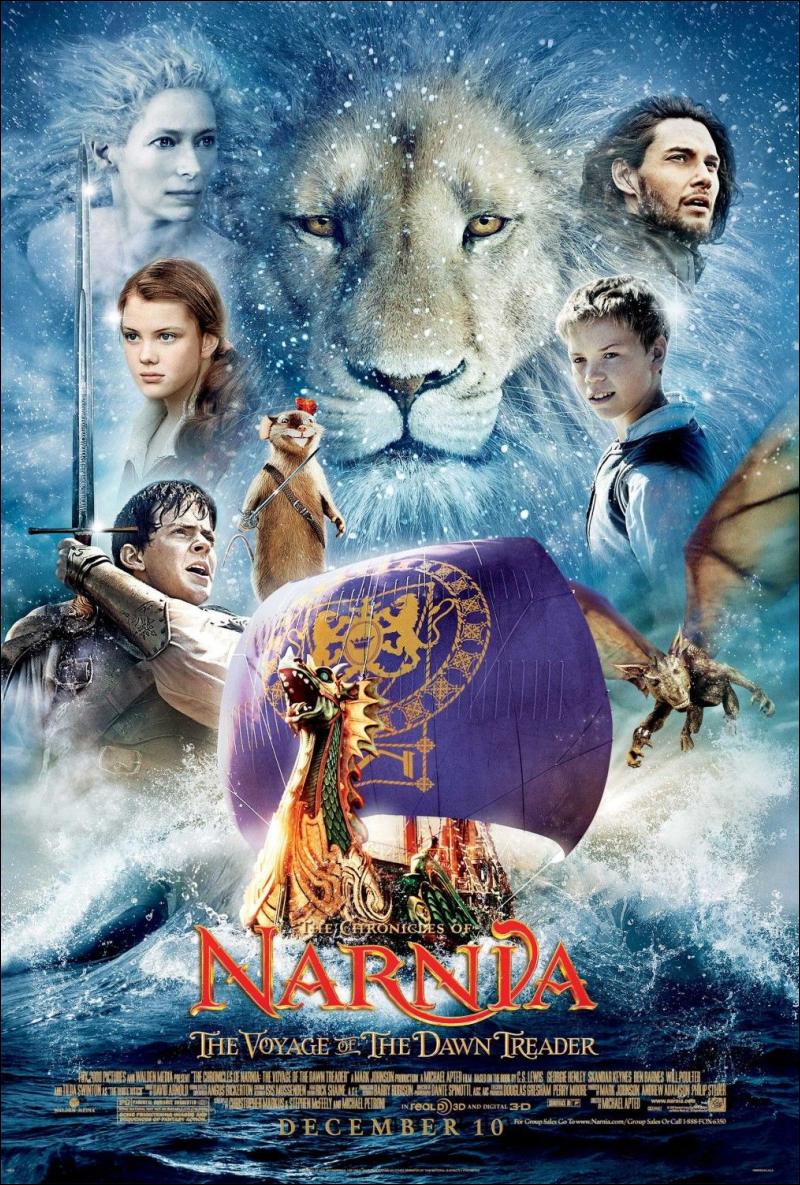Taglines: Return to magic. Return to hope. Return to Narnia.
Return to the magic and wonder of C.S. Lewis’ beloved world — via the fantastic Narnian ship, the Dawn Treader. In this new installment of the blockbuster The Chronicles of Narnia motion picture franchise, Edmund and Lucy Pevensie, along with their cousin Eustace, their royal friend King Caspian and a warrior mouse named Reepicheep, find themselves swallowed into a painting and onto the Dawn Treader.
Their mission — on which rests the fate of Narnia itself — takes the courageous voyagers to mysterious islands and a river that turns to gold, to fateful confrontations with magical creatures and sinister enemies and to a reunion with their friend and protector, the Great Lion Aslan.
This time around – Edmund and Lucy Pevensie, along with their pesky cousin Eustace Scrubb – find themselves swallowed into a painting and on to a fantastic Narnian ship headed for the very edges of the world. Joining forces once again with their royal friend Prince Caspian and the warrior mouse Reepicheep, they are whisked away on a mysterious mission to the Lone Islands, and beyond.
On this bewitching voyage that will test their hearts and spirits, the trio will face magical Dufflepuds, sinister slave traders, roaring dragons and enchanted merfolk. Only an entirely uncharted journey to Aslan’s Country – a voyage of destiny and transformation for each of those aboard the Dawn Treader – can save Narnia, and all the astonishing creatures in it, from an unfathomable fate.
The Story
Published in 1952, “The Voyage of The Dawn Treader,” a grand, episodic adventure, is the third of C.S. Lewis’ seven-book “The Chronicles of Narnia” series. The story’s events take place about three Narnian years after the preceding novel, “Prince Caspian.” While the two elder Pevensie siblings are away — Peter studying for university entrance exams; Susan on holiday in the U.S. — the two youngest, Lucy and Edmund, are reluctantly visiting a relative at his home near Cambridge in wartime England, circa 1943. Lucy and Edmund’s greatest challenge there is dealing with their annoying cousin Eustace Clarence Scrubb – until the three young people come across a painting of The Dawn Treader, a majestic sailing vessel whose look was inspired by dragons.
The canvas suddenly and inexplicably comes to life, flooding the room and submerging the teens before transporting them to Narnia’s Eastern Sea, where they are rescued by King Caspian and his crew aboard The Dawn Treader, the very same single-masted ship depicted in the artwork. Edmund and Lucy are thrilled to be back in the land they once ruled as a High King and Queen; the perpetually-whining Eustace, a newcomer to this world, is much less enthusiastic. The trio soon learns the reason for Caspian’s voyage east: He is fulfilling an oath to find the seven lost Lords of Telmar, the best friends of his murdered father. Their journey takes them to five islands, each of which brings the ship’s crew unexpected peril and adventure, and each has its own hidden, seductive secret. Caspian and his men discover the existence of an evil green mist that has powers to kidnap not just people’s bodies, but their minds as well.
A wise old magician, Coriakin, explains to Caspian and the Pevensies, that to break this deadly spell they must find the seven Lords and retrieve each of the swords gifted to them by Aslan to protect Narnia. Once collected and laid upon Aslan’s banquet table, the swords will empower them to defeat the mist and the Witch. Without this union of the seven swords, they and Narnia will be destroyed.
The voyagers’ task is daunting, as they must brave violent seas and a monstrous sea serpent, among other dangers. As they embark on this life-changing journey, their courage and beliefs are tempted and tested in a voyage of destiny and transformation that takes them to the far edges of the world.
While Lewis’ first book set in Narnia, “The Lion, the Witch and the Wardrobe,” may be the series’ most famous and popular, many devotees of Lewis’ classic stories point to “The Voyage of The Dawn Treader” as the best of all seven “Narnia” novels. “It is certainly one of the most beloved books in the series,” says producer Andrew Adamson. “‘The Voyage of The Dawn Treader’ returns to the wonder, magic, awe and adventure of ‘The Lion, the Witch and the Wardrobe.’”
In adapting his third “Narnia” book to the screen (with longtime writing partner Christopher Markus, and Michael Petroni), screenwriter Stephen McFeely notes that “the most challenging aspect of writing the screenplay was keeping the highly individual flavor of each island adventure, without letting the film get too episodic. This film should feel of a piece with the two preceding films, as a unified Narnian epic, while at the same time introducing lands, species and issues that we hadn’t encountered in previous stories.”
Michael Apted, the franchise’s new skipper, was drawn to the project because, he says, “The film is about two simultaneous journeys. One is an adventure through unchartered and dangerous seas, and the other into their own selves as they grow into adulthood. Just as they overcome the forces of evil they meet on the journey so they learn to deal with temptations and, in doing so, find their true character. That’s what they learn in Narnia, so at the end of our story they are ready to leave and get on with their lives. That’s the universal theme that Lewis presents to us in his book.”
While remaining true to the book’s spirit, emotions and characters, the filmmakers made some necessary adjustments to bring Lewis’ story to the screen. Apted explains: “In the book, the narrative thread revolves around Caspian’s search for seven Lords, but in the film, the quest is for seven swords. The threat of the Green Mist, as depicted in our film, isn’t really touched on in the book ‘The Voyage of The Dawn Treader’ – though it does appear in a subsequent book.”
“In the film, the quest for the seven swords is there to reinforce the purpose of Caspian’s journey to the edge of the world,” executive producer Douglas Gresham elaborates. Gresham, who is C.S. Lewis’ stepson, has made it a lifelong mission to bring Lewis’ books to the screen. “The film’s sword motif is an addition to the book’s storyline about the seven Lords of Telmar and has been added to help drive the story forward to keep the audiences enthralled.”
The filmmakers were also careful to maintain the book’s thematic integrity. “The Chronicles of Narnia: The Voyage of the Dawn Treader is a story largely about temptation,” Gresham relates. “Along the journey, Caspian, Eustace, Lucy and Edmund and the entire crew of The Dawn Treader face many challenges and adventures, and cope with the accompanying temptations. Each character meets his or her deepest temptations, which we have seen glimpses of in the previous movies.”
“Fear and temptation are the principal issues the characters face, and those themes point to the ‘Narnia’ books’ weight and substance,” adds Apted. “The film reminds us that you have to know yourself to deal with temptation and fear. That, too, is part of becoming an adult.”
The Actors and Their Voyage
Georgie Henley was the first actor cast after the filmmakers began their search in 2003 for the Pevensie siblings in “The Chronicles of Narnia: The Lion, the Witch and the Wardrobe.” When Georgie was spotted by a London-based casting director, the youngster was all of seven years old, and had no professional acting experience. Now, eight years later — Georgie has spent almost half her life in the folds of Narnia — she has blossomed into a beautiful teenager. Moreover, Georgie’s personal journey through the three movies mirrors what her character Lucy experiences, especially in the new film. Of course, Lucy’s adventures take place in the wondrous world of Narnia; Georgie’s are in a different land of fantasy — Hollywood.
“I was a bit nervous coming back to Narnia for the third time,” Georgie admits. Perhaps her anxiety stemmed from the realization that she was the only major female character in the story, because Lucy’s older sister Susan’s journey through Narnia ended in “The Chronicles of Narnia: Prince Caspian.” Additionally, Lucy has changed a lot since her previous visit to Narnia. “She’s going through that stage where everybody feels insecure,” says Georgie. “Lucy still wants to be her sister Susan and be beautiful like her, because everybody knows that Susan is absolutely gorgeous.
“The characters’ journeys are all about temptation, and in this film you see Lucy as a more complex person,” Georgie continues. “In the first two films, she’s portrayed as honest and true and sure. Now, she’s more complex. And I think her journey is overcoming her challenges and realizing that she is human, she’s growing up, and the feelings she has are normal.”
About her journey through Narnia these past seven years, Georgie notes, “Skandar [Keynes, who portrays Edmund] and I have grown up with these characters. I feel quite connected to Lucy because she’s been a huge part of my life.”
Skandar Keynes was cast at age 12 as the treacherous Edmund in the first movie. And, while Georgie might continue her acting career (“What I will take away from Narnia, among many other things, is a passion for acting,” she admits), Skandar has different plans. During filming of The Chronicles of Narnia: The Voyage of the Dawn Treader, Skandar sought admission to Cambridge University, where he will focus on Arabic studies. (His mother hails from Lebanon.) Having won admission to the revered institution of higher learning (where C.S. Lewis taught literature from 1954-63) a few months after filming concluded, Skandar has begun a sabbatical from his performing career to pursue his academic studies.
As his final days and hours in Narnia drew near, the only tension Skandar felt was awaiting word on whether he had won admission to Cambridge. Not unlike his character at the end of the long sea voyage, when Aslan explains to Edmund and Lucy that they are destined never to return to Narnia, Skandar was making the transition from childhood to adulthood. “You know, after six years of being involved in the ‘Narnia’ films, I have to be so thankful for this experience,” he relates. “It’s really helped me in so many ways. I’m now more confident than I thought possible. It’s given me the courage to stand up and to take on tasks. I’m ready to move on. Where that’ll take me, I don’t know. But, I’m happy and content.”
For Skandar’s Edmund, the journey on The Dawn Treader means facing a formidable temptation, in the form of the villainous White Witch, once again portrayed by Tilda Swinton. Having lived in the shadow of older brother Peter, Edmund is determined to be his own man. The White Witch, a powerful antagonist in the first film, appears in Edmund’s dream, offering the young man power and glory surpassing even his brother’s achievements.
Narnia: The Voyage of the Dawn Treader (2010)
Directed by: Michael Apted
Starring: Ben Barnes, Skandar Keynes, Georgie Henley, Will Poulter, Bill Nighy, Bruce Spence, Laura Brent, Tilda Swinton, Tilda Swinton, Anna Popplewell, William Moseley, Shane Rangi
Screenplay by: Christopher Markus, Stephen McFeely
Production Design by: Barry Robison
Cinematography by: Dante Spinotti
Film Editing by: Rick Shaine
Costume Design by: Isis Mussenden
Set Decoration by: Rebecca Cohen
Art Direction by: Ian Gracie, Daniel May, Karen Murphy, Marco Niro, Mark Robins
Music by: David Arnold
MPAA Rating: PG for some frightening images and sequences of fantasy action.
Studio: 20th Century Fox
Release Date: December 10, 2010

